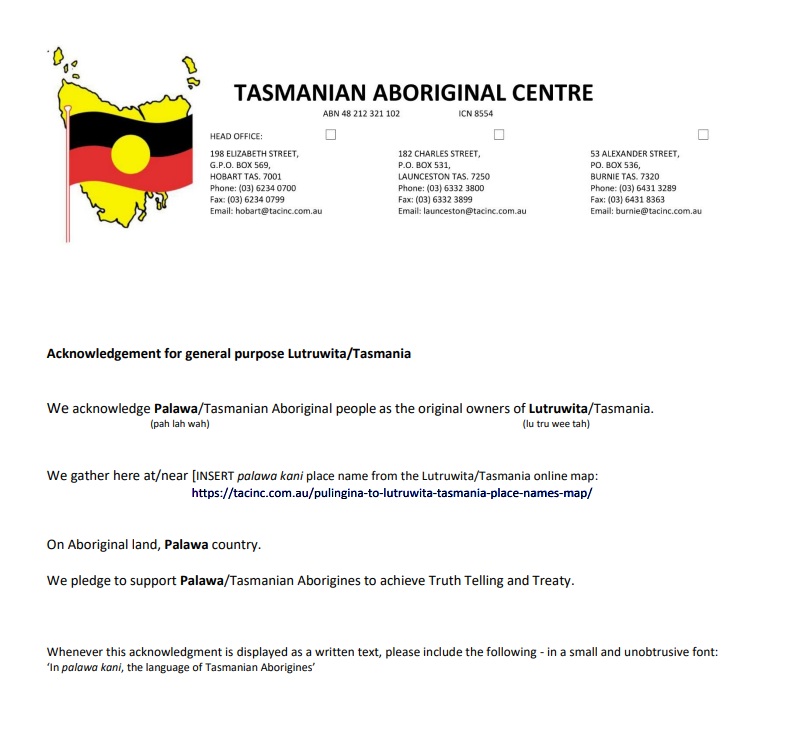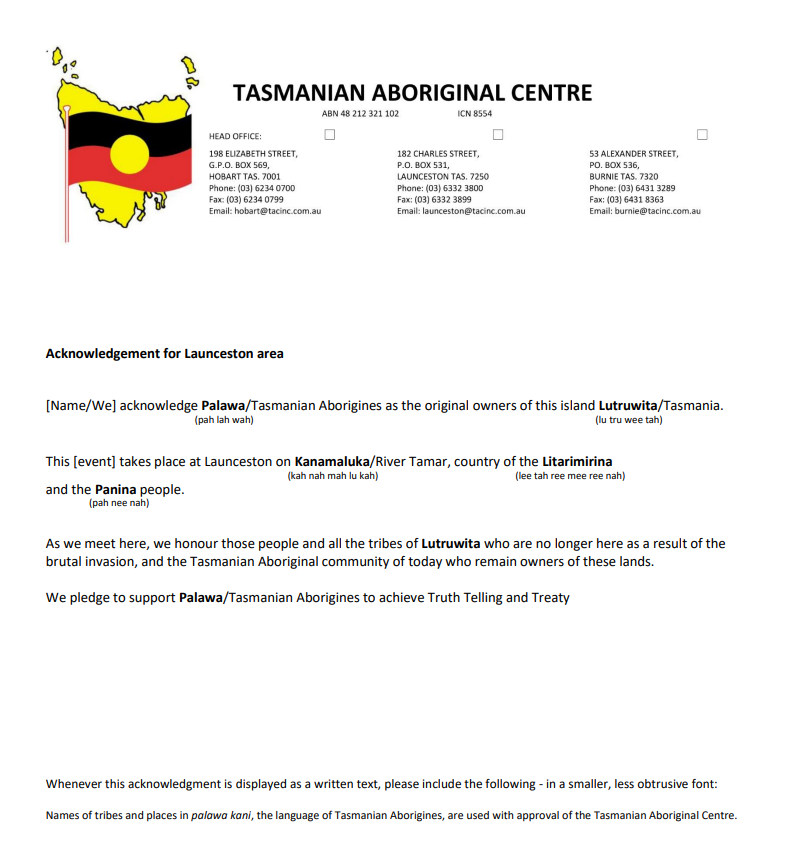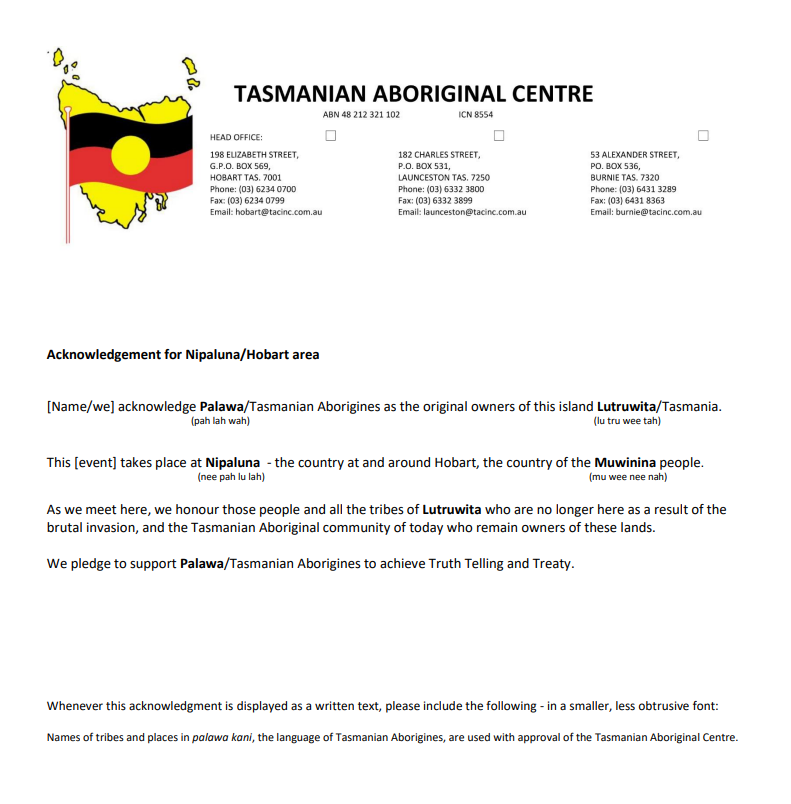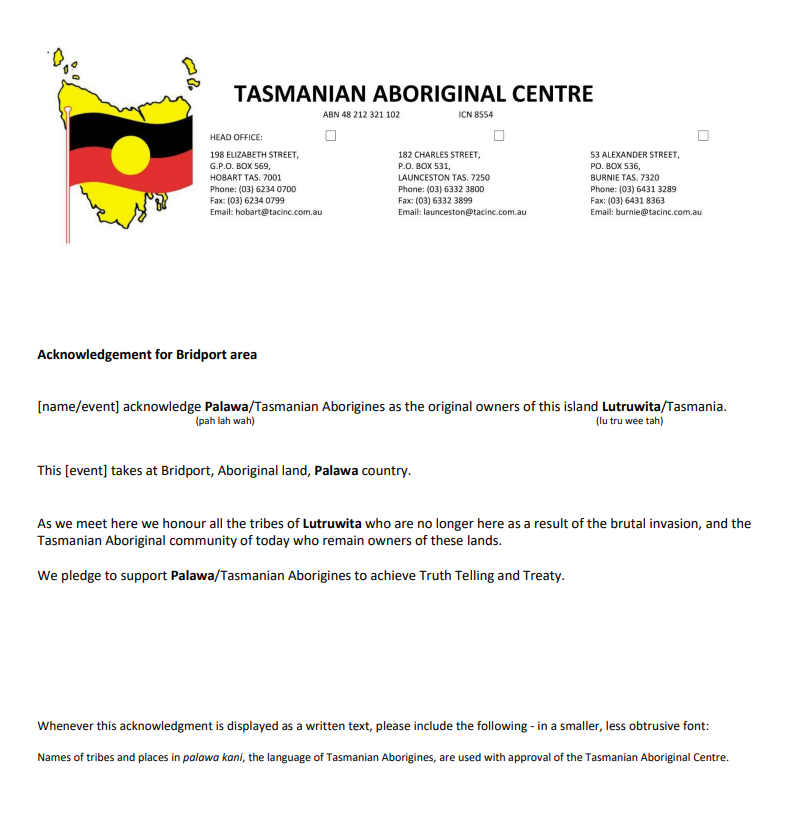About palawa kani, the language of Tasmanian Aborigines
palawa kani means ‘Tasmanian Aborigines speak’; it is the only Aboriginal language in Lutruwita/Tasmania today.
Tasmanian Aborigines did not grow up speaking our language as a first language – there is no shame in that. As a consequence of the devastating impacts of invasion and colonisation on every aspect of our lives, we have had to deliberately and arduously restore our language to its spoken life.
After two decades, Aboriginal people of all ages can now speak palawa kani, the language of Tasmanian Aborigines, and children learn it from an early age. Read how we, like many other Indigenous people around the world, and using the same methods, have brought our language back to life.
The Tasmanian Aboriginal Centre is acknowledged both within and outside the Aboriginal community as the body with responsibility for that work, conducted by the palawa kani Language Program across the state since the early 1990s.
The palawa kani Program was among the first in the country in which Aboriginal people ourselves learnt the necessary linguistic methods which have since enabled us to do all the retrieval work on our language.
Check out our YouTube channel, palawa kani playlist, which has videos and speeches in palawa kani:
- palawa kani playlist on YouTube (external link)
Some of the language material displayed on this website was produced with the assistance of funding from Indigenous Languages and Arts, Australian Attorney-General’s Department.
Original languages
There are no living speakers of the original Tasmanian languages and spoken records of the original sounds are limited to a few sounds (that can only just be heard) which were spoken by Fanny Cochrane Smith on the 1899 record on which she sang traditional songs.
Between eight and 16 separate languages could have been spoken here originally; we will never really know. Some tribes had been wiped out by contact sicknesses even before full scale invasion and the languages continued to die away with the people.
Fortunately, remnants of many of those original languages were written down in wordlists by more than twenty different European recorders, starting from Cook’s visit in 1777 right through the colonial period. Most of these recorders were speakers of different regional dialects of English; another was a Scot, one a Danish, many were French.
Each of them attempted to reproduce the unfamiliar sounds they heard in the Aboriginal words through the spelling system of their own languages. Different recorders wrote different spellings for the same word, and individual recorders even wrote several different spellings for the same word, indicating they heard it on different occasions and from different Aboriginal speakers
Their different records also show frequent disagreement and confusion about the meanings of the words, and about the area of origin of either the word or its Aboriginal speaker, and often both.
Most tragic of all, there aren’t enough words or information recorded of any of the original languages to rebuild any one of them exactly as it was. As a result, palawa kani combines words retrieved from as many the original languages as possible.
This brings us to the first of several major misunderstandings:
Firstly, some people think if you select a word or words from a wordlist, which the recorders have said are from the same area, you have ‘Aboriginal words’ of a ‘local language’. But a word list, however well or poorly researched and compiled, is just that: a list of ‘words’, not a language. Furthermore, we have found through over a decade of historical and linguistic research that not all the information given by recorders about the areas or languages they said the words came from is reliable, and some is just plain wrong.
Secondly, you need to look further than published books and compilations of wordlists to find evidence for languages no longer spoken. A wealth of manuscript material from the colonial period is amassed in libraries and other institutions both in Australia and overseas, and this primary source material contains the first-hand observer accounts necessary for the scholarship required to retrieve evidence of sleeping languages.
These primary source records, together with a very few later audio recordings of Tasmanian Aboriginal speech, and language remembered into the twentieth century, are the sources for palawa kani. We were able to collect over two hundred words, phrases and song fragments from the memories of over thirty Aboriginal people throughout the twentieth century. Many of these duplicate each other, across different families and time periods, and from both mainland Tasmania and the Bass Strait islands. People living today still sing songs they learned as children, which they have taught their own children, and these are recognisably anglicised versions of songs recorded from Aborigines in the 1830s.
The third misunderstanding is that the spellings that appear in various lists of recordings of Aboriginal language are Aboriginal words. In fact, they are only approximations by those European scribes of many nationalities who tried to capture unfamiliar Aboriginal sounds in their own European spellings. Those spellings of words written by the recorders, and since published by Plomley, Ryan, and other historians and writers in their books, and which now appear everywhere – on websites, in museums and other interpretative displays – are not in themselves Aboriginal words.
Retrieving evidence of the original languages
The recorders’ spellings are essential to the palawa kani language program.
Without them we do not have any representation of how our languages sounded, and what the words meant. It is possible to use those spellings (also called ‘recordings’ and ‘spelling variants’) as a starting point for bringing back the words they represent to as close to their original sounds and correct meaning as is possible.
It is fortunate that there were so many different recorders of the original languages because this allows us to compare spellings and meanings. The palawa kani Language Program team recognised however, that the value of any recording is only as credible as the person who wrote it down. One of the Program’s earliest tasks was to determine the most accurate, hence most reliable, recorders of the sounds and meanings. This enabled us to identify the strengths and weaknesses of individual recorders. These factors are taken into account with every word revived.
A linguistic research project undertaken by the palawa kani Language Program in the 1990s confirmed what sounds existed in the original languages, and an alphabet was custom designed to represent those sounds, in line with the decisions made by Aboriginal community members at large statewide meetings.
To retrieve the authentic sounds of each individual word, those spellings from the recorders are analysed through a linguistic process called ‘reconstruction’.
‘Reconstruction’ is a linguistic term for a standard process used world-wide in the recovery of languages which are sleeping or no longer spoken; most of these are indigenous languages. Unfortunately this term is too easily misunderstood or wilfully misinterpreted. It does not mean ‘to construct’ a language, or ‘to create’ one – in the sense of just making things up from no evidence, or randomly selecting European spellings from wordlists, and claiming those words to be ‘language’. On the contrary, it is a rigorous process by which linguists and language workers recover the original sounds and meanings of the words of a language from all the recorded versions of the words.
The most likely sounds of each word are determined by comparing the spellings of all the recorded versions of that word. All the possible spellings are transcribed into the International Phonetic Alphabet (IPA), which contains symbols for every possible sound in human speech. Through this analysis, we are able to determine as closely as possible the original sounds recorders tried to represent with their spellings. Those sounds are then written in the palawa kani sound and spelling system (alphabet).
The word’s meaning is worked out in a similar way, by comparing the translations given for all the recorded versions of that word and cross checking these where possible with the reliability of the recorder/s, the context of when, where and from whom the recording was made, the accuracy of the language region given by the recorder/s, other historical information related to the subject of that word, and cultural knowledge still held within the Aboriginal community.
For words for places and tribes, further historical and geographical research is often also necessary, together with knowledge still held within the Aboriginal community today. Only this thorough research ensures that words revived are, as far as possible, from the original language of the place. Taking information from wordlists at face value is how mistakes are made. A good example of this is the name for the Mersey River. Tulaminakali (spelt ‘tollumenergully’ by Robinson) is the proper name. This is a word from the Port Sorell language, the northern language spoken in that area, and shared with Robinson when he travelled with two Port Sorell tribespeople in April 1832 to the Mersey River and the ochre site on the Gog Range. Tulaminakali shares characteristics with the name of that important ochre site – Tulampanga – and with other northern language names for places in that area. Yet another word in its English spelling – ‘paranaple’ – has been selected to name the Devonport Arts Centre; a word with no information at all about its provenance, recorded at Wybalenna by a recorder who, by his own admission, did not know the people well nor where they were from; and which, in a related form is also recorded to mean the Tamar River.
palawa kani
Applying this methodical process to the evidence from all the historical sources gives us the best chance to revive authentic Tasmanian Aboriginal language, as close as possible to the way it sounded before contact with European or other languages. However, palawa kani is not exactly the same as any of the original Tasmanian Aboriginal languages.
Participants in community workshops of 1993 and 1994 understood that the remnants of each of the original languages were not enough to revive any single one of them, but that one language could be retrieved from the records of them all. This mirrored the way in which the families of the survivors of the invasion, from wherever they all now lived throughout Tasmania, had since coalesced into one statewide Aboriginal community; and the language remembered in families from both the Bass Strait Islands and Channel areas also shows that a ‘mix’ of words from several original languages had been used from at least the start of Robinson’s ‘Mission’ and then throughout the Wybalenna period.
It was also believed that the revived language would inevitably need to rely upon grammatical features of English, as little or no evidence was thought to remain of original grammar. This was the assessment of some earlier linguists, based on small samples of records in wordlists. Since that time, the painstaking examination, word by word, of the original languages for the first time ever, by the palawa kani Program, has revealed clear evidence in the original languages of consistent patterns of use and grammatical functions which are now continued in palawa kani: ways to make plurals, word orders different to English, a range of suffixes to denote specific functions, borrowings, adaptation of traditional words to talk about things newly introduced by Europeans, to list a few.
Such grammatical structure is an integral element of an actual functioning language; and cannot possibly be gleaned from grabbing isolated words from wordlists.
So when people trawl through Plomley’s Wordlist, the 1966 compilation of most (but not all) of the recorders’ wordlists, for any one ‘word’ they may find an array of multiple and differing spellings. Faced with this, most people looking for an Aboriginal language word, simply opt for the easiest to say or the one with the prettiest or most fanciful translation.
An example of this is a phrase that is sometimes used as a ‘greeting’ – ‘yah! tahwattya’. The ‘yah’ part is indeed a greeting, spelt in palawa kani as ‘ya’ (hello). However, ‘tahwattya’ is an English spelling of a word for ‘catarrh’ – a respiratory-type illness not common before invasion (spelt takwatja in palawa kani). All the five variants of this word were recorded by surgeon Joseph Milligan, at Wybalenna where the people were dying of these introduced illnesses; two of his five spellings he translated as ‘woe’s me’; two others as ‘cough’ and ‘catarrh’; and one, with ‘yah’ attached, as ‘greeting’. Milligan is one of the most unreliable recorders of translations, and the comparative examination of his five recordings confirms this, as they show that what Aborigines were saying was something like, ‘Hello, I’m sick/feeling miserable’; and not ‘Hello, how are you?’
So, some twenty years on, isn’t it wonderful that we can honour the memory of the original languages and their speakers– our Ancestors – by bringing back into use those words that have until recently been resting.





